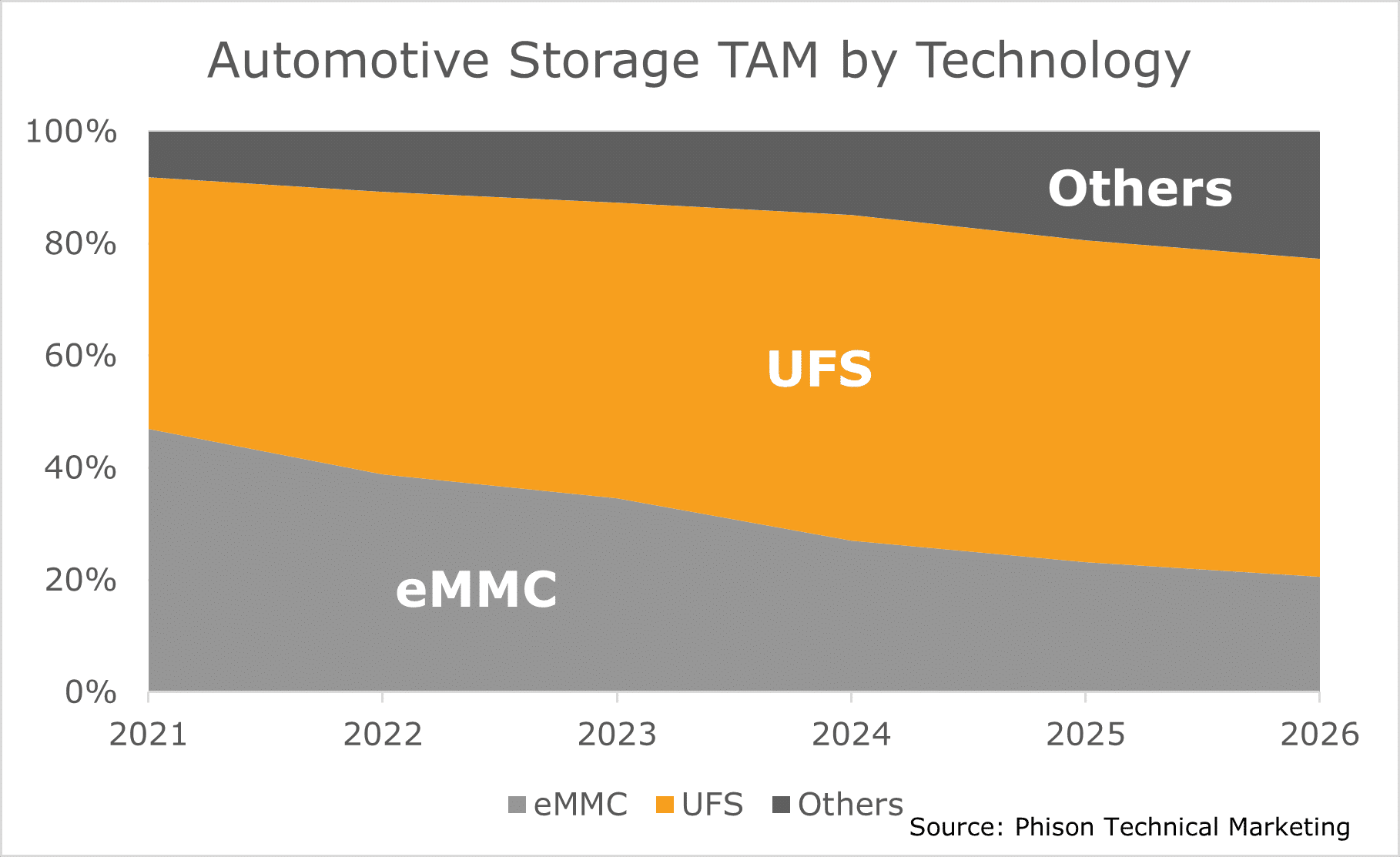This is the second article in a 5-part series about automotive storage. In this piece we take a look at the major application of NAND storage in a modern vehicle and why intelligent cockpits require so much storage.
As mentioned in our previous article, NAND flash storage in cars is mainly used in four major areas: telematics control units, infotainment systems, central gateways and advanced driving assistance system (ADAS). Despite the fast-growing popularity of ADAS, the main demand for NAND flash storage in the next five years will still be in infotainment system, which account for 80% of the total available market of automotive NAND storage. In this article, we will explore the applications of this system and future trends of the storage technology here.
Beyond mechanics, cockpits feature more intelligence and entertainment
In the past, people were always concerned about the horse power, engine, speed, interior material, and even the strength of its steel. However, today’s consumers are more interested in whether there are 12-inch or 17-inch large screens. How is the image quality and smoothness of operation? Can it support Android Auto or Apple Car Play and streaming media? Does it support features such as OTA, AR head-up display, and voice recognition? How intuitive are the 360-degree surround view and rear-view camera display?
With the rapid development of ADAS technology, people have more attention to focus on entertainment applications in the digital cockpit. For example, Tesla’s cockpit system allows people to play AAA games, and Xiaopeng’s AI assistant Xiao P can interact with drivers through voice commands. Earlier this year, BYD also announced its cooperation with NVIDIA to enhance the in-vehicle experience by introducing the NVIDIA GeForce NOW™ cloud gaming service into their vehicles.
In simple terms, the applications in automotive cockpit is undergoing explosive growth to provide people with a better in-vehicle experience. Ultimately, this trend is rapidly driving the requirement for hardware systems, including the performance and capacity of NAND storage devices (Figure 1). Let’s take a deeper look at the evolution of NAND flash storage devices in automotive cockpit system.

(Figure.1) The evolution of intelligent cockpit is transforming vehicle storage requirements
The Rising Popularity of UFS Standard in Automotive Storage
The performance of the automotive cockpit system undoubtedly depends on the SoC (System on a Chip) of the system. In the past, we have seen major IDM (Integrated Device Manufacturer) companies such as Texas Instruments, NXP, Renesas Electronics, and STMicroelectronics become the main suppliers of the infotainment SoCs, thanks to their long-term presence in the automotive industry and established business channels. eMMC is the mainstream storage interface supported by these suppliers’ SoC products. Without a doubt, in markets other than personal computers and servers, this mature embedded storage solution is the preferred choice for various terminal devices.
However, the market is always changing rapidly. In the past six to seven years, companies like Qualcomm, MediaTek, and Samsung have entered this market with their experience and products in the mobile market, leveraging their cost and performance advantages. These SoCs that were originally designed for smartphones and tablets have taken away market share from the traditional IDM companies with more advanced process node and powerful performance. These mobile SoCs compete fiercely in the rapidly iterative consumer market, and their chipsets have shifted towards the faster UFS (Universal Flash Storage) standard for storage devices. This has also driven the demand for UFS in automotive cockpit systems. Currently, UFS has generated more sales revenue than traditional eMMC in the overall automotive storage market and has become the mainstream storage technology for automotive applications (Chart 1).

(Chart 1) Automotive storage TAM forecast based on revenue
In addition to the changes in SoCs and applications driving the system to adopt UFS rather than eMMC, there are two more fundamental reasons: capacity and bandwidth.
First, in terms of supply and product differentiation, eMMC is more commonly used in the global market for low-end smartphones, smartwatches, smart TVs, and set-top boxes, which have relatively low capacity requirements. On the other hand, UFS is widely used in mid-range to high-end smartphones and head-mounted devices such as VR and AR, with capacities ranging from 128GB to 512GB. As the capacity requirement for automotive cockpit and infotainment systems increase, NAND flash storage suppliers can provide high-capacity UFS solutions instead of high-capacity eMMC to ensure supply consistency.
Second, performance. The time it takes for UFS from power on to receive the first command can be around 60ms, whereas eMMC may take up to 300ms. In addition, there is a significant difference in bandwidth. The eMMC 5.1 standard can achieve a maximum speed of 320MB/s in sequential read, while the UFS 3.1 standard can read data at speed close to 2000MB/s, significantly reducing the boot time of cockpit operating system, as well as loading time for various applications and multimedia (Chart 2). Furthermore, the improvement in write speed also contributes to faster download speed of OTA, apps, and map to provide better user experience. Currently, high-end smartphones have adopted the UFS 4.0 standard. However, considering the development, validation, and production cycle of automotive systems, car manufacturers have not yet implemented the UFS 4.0 storage solutions. Nevertheless, we can expect that the introduction of UFS 4.0 in the future will bring even more exceptional driving and passenger experiences.

(Chart 2) Comparison of ideal sequential read performance of embedded storage solutions
Phison – The Leading Provider of Automotive Storage
The user experiences provided by the cockpit and infotainment system have become important indicators for consumers when considering a car. Automakers are constantly introducing new features, including more sophisticated navigation systems, voice recognition and interaction, heads-up displays, gaming platforms, 360-degree surround views, and support for streaming media. Automakers also aim to generate revenue from software services by offering a variety of functions and application downloads through OTA. The increasing demand for these terminal applications has led to higher hardware requirements for the system, making UFS gradually replace eMMC in entertainment and cockpit systems, becoming the mainstream technology for automotive NAND flash storage devices.
With over a decade of experience in developing products for the automotive storage market, Phison, as the world’s largest supplier of automotive eMMC controller, has already launched automotive UFS solutions in response to market demands. The existing solutions include UFS 2.1/UFS 3.1 with capacities ranging from 64GB to 512GB. All UFS solutions have passed the AEC-Q100 test comprehensively and the production fully complies with the IATF-16949 standard. In addition to comprehensive product portfolio, Phison’s automotive UFS solutions have also entered the Approved Vendor List (AVL) of several leading cockpit/infotainment SoC suppliers, thereby assisting automakers and Tier1 system integrators in accelerating the development of cockpit and infotainment systems.
Having discussed how the changes in automotive cockpit and infotainment systems are driving the demand for automotive UFS, our next article will introduce the fastest-growing storage solution in automotive storage, PCIe SSD, and how it addresses engineering issues in automotive systems. Don’t miss the third article in our automotive storage series.










